
unreachable code
Unreachable Code: The Hidden Pathways of Programming Logic
Unreachable code, as its name suggests, is a section of code that the program's flow cannot reach under any circumstances. It's like an island cut off from the mainland, existing in isolation but without any means of access.
The reasons for unreachable code are numerous. It could be due to a return statement in the middle of a function, an infinite loop that prevents the following lines from running, or conditional statements that ensure certain blocks of code are never executed.
Although unreachable code might seem harmless, it's generally seen as a bad practice in programming. It unnecessarily takes up memory and can lead to confusion and errors, making the code harder to understand and maintain.
Moreover, unreachable code could be a sign of underlying issues, such as bugs or logic errors. It might indicate that the programmer has made a mistake when writing the conditional logic, or that some part of the program is not functioning as intended.
Many modern programming environments and compilers flag unreachable code as a warning, helping developers spot and rectify it. While it's not an error that would prevent a program from running, it's an issue that needs attention for clean, efficient code.
While the concept of unreachable code might seem abstract, understanding it is crucial. It sharpens a developer's logic and helps maintain code that is efficient, clean, and easy to understand. After all, coding is not just about getting the program to work, but about creating something that's robust, scalable, and maintainable.
As we conclude our dive into unreachable code, let's enjoy a light-hearted coding riddle: Why don't programmers ever get lost in their code? Because even if they find a path that's unreachable, they know there's a 'return' at every corner! Programming might have its challenges, but it's always an adventure waiting to unfold!
Let’s build your next digital product — faster, safer, smarter.
Book a free consultationWork with a team trusted by top-tier companies.








